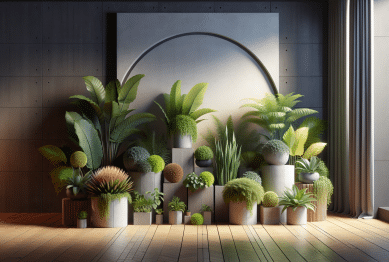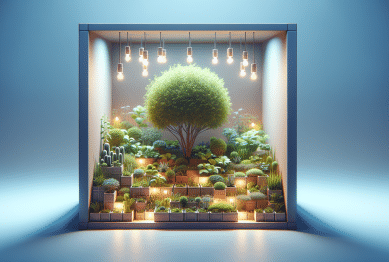Dive into the fascinating world of smart home gardening and explore approaches that make gardening efficient, eco-friendly, and surprisingly simple. Learn about smart garden systems, plant care techniques, and how technology can transform home garden experiences.
Why Smart Home Gardening Captivates So Many
Smart home gardening has rapidly become a sought-after trend that merges digital innovation with timeless gardening joy. Many people find themselves drawn to gardens for their soothing qualities, but busy routines often limit traditional gardening efforts. Integrating smart technology makes it possible to grow beautiful plants with less time and effort. Systems like automated irrigation and app-controlled lighting help keep plants healthy, even when routines get unpredictable. For those with a passion for sustainability, these tools can optimize water usage and reduce waste, creating gardens that thrive and conserve resources at the same time.
There’s something inspiring about the accessibility that smart home gardening offers. Newcomers to gardening appreciate the simple guidance that many systems provide, while enthusiasts enjoy tinkering with advanced plant monitors and hydroponic setups. With a wide range of options, from compact countertop herb gardens to sprawling outdoor smart beds, it’s easier than ever to find solutions matching any living space or skill level. As technology helps demystify plant care, even complex tasks such as tracking soil nutrition or perfecting watering schedules become feasible—even fun.
Smart gardens support eco-friendly living. Automated irrigation systems distribute just the right amount of water per plant, often leading to significant water savings over time. Some systems offer sensors capable of measuring sunlight, soil moisture, and temperature for each plant. This data-driven approach produces predictable, lush results. With increased interest in eco-conscious choices, incorporating smart technology into gardening can help foster greener, more sustainable communities without adding to personal workloads.
Key Technologies Powering Modern Home Gardens
Several core technologies have revolutionized how people approach home gardening. Automated irrigation is one such innovation—customizable, programmable watering keeps soil at the ideal moisture level, removing guesswork from plant care. Gardeners can adjust schedules that correspond with local weather forecasts, ensuring plants aren’t over- or under-watered. Many systems pair with mobile apps, allowing remote adjustment from anywhere with internet access.
Smart lighting systems change the growing game, especially for indoor gardeners. LED grow lights can replicate sunlight spectrums and adjust intensity based on plant species or growth stage. These programmable systems ensure optimal photosynthesis regardless of the season or natural daylight availability. Some smart lights even learn a plant’s needs over time, adjusting automatically to support strong, healthy growth.
Another advancement is the use of plant monitoring sensors. These compact devices track data on soil moisture, temperature, humidity, and light exposure. Gardeners receive real-time notifications to their phones, offering clear advice on when to water, fertilize, or adjust lighting. Sophisticated kits even analyze growing conditions and recommend plant-specific care plans. By leveraging these technologies, people can nurture vibrant, resilient plants with confidence, even with little prior gardening knowledge.
Choosing Plants That Thrive With Smart Gardening
Selecting suitable plants is critical when setting up a smart home garden. Certain varieties respond especially well to controlled environments and can flourish with smart systems. Herbs such as basil, mint, and cilantro adjust well to hydroponic and app-managed setups, making them favorites for kitchen countertop gardens. Leafy greens—think spinach, kale, or lettuce—also require minimal space and can thrive under LED lights and monitored watering conditions. People enjoy growing these low-maintenance options virtually year-round.
Tomatoes, strawberries, and peppers are highly popular among home gardeners looking for productive harvests. Many new smart gardening kits come with recommended plant pods, simplifying the selection process. Gardeners often experiment, discovering that even ornamental plants or succulents manage well under hands-off systems. Sensor data helps identify the best conditions, making it possible for exotic species to take root successfully indoors or out.
Smart gardens encourage experimentation. Many people start small, then expand as confidence grows. Over time, a simple herb garden can evolve into a vibrant display of edible and decorative plants. Regardless of plant type, the core benefit remains: technology streamlines care and empowers gardeners of all experience levels. This wave of smart solutions has helped remove barriers that might otherwise limit who can enjoy a flourishing garden at home.
Maximizing Water Efficiency and Resource Savings
Water conservation is a top priority for both sustainability and plant health. Smart irrigation systems leverage weather and soil data to prevent overwatering—a practice that protects roots and saves resources. Homeowners can program watering schedules or allow AI-assisted controllers to automatically adjust how much water each garden section receives. This results in robust plant growth and measurable reductions in water usage over time.
Micro-drip irrigation is another smart technology utilized in water-wise gardens. Instead of widespread sprinkling, micro-drip systems deliver moisture directly to plant roots. This targeted approach ensures every drop serves a purpose, making it ideal for climates with limited rainfall or in urban settings where water bills are a concern. Users find that plants flourish with consistent access to soil moisture, while waste due to evaporation or runoff drops dramatically.
Rainwater harvesting—another resource-conscious addition—complements smart gardening systems. Captured rain can be filtered and used in automated irrigation, further reducing dependency on municipal supplies. Paired with connected sensors, rain collection tanks help homeowners track usage patterns and optimize supply based on actual garden needs. Adopting multiple smart features amplifies results: healthier plants, lighter bills, and a reduced environmental footprint.
Making Smart Gardening Accessible for Everyone
Smart home gardening removes many barriers that have kept people from gardening in the past. For those without traditional outdoor plots, compact and modular gardening systems make growing possible indoors—even in small apartments. Self-watering planters, wall gardens, and stackable units offer space-saving alternatives. These solutions transform balconies, kitchens, and urban windowsills into lush, productive gardens with minimal oversight.
Cost is an important consideration. While some smart gardening systems do require upfront investment, many people find savings over time. Fewer plants are lost to neglect or improper care thanks to integrated monitoring and guidance. Features like programmable lights and water-saving irrigation also produce cost savings on utilities or grocery bills. With more brands producing affordable, user-friendly kits, it’s becoming possible for a wider audience to participate in smart gardening.
The educational value of smart gardens is not to be underestimated. Families often use these systems to introduce children to plant science, responsibility, and sustainability principles. Many platforms include learning resources and interactive features, making the experience both enjoyable and informative. Smart gardening empowers individuals of all backgrounds to nurture living things and connect with the natural world—no green thumb required.
Tips for Getting Started and Succeeding With Smart Gardening
To begin a smart gardening journey, start by identifying available space and light conditions. Many products are designed with flexibility in mind but knowing where the garden will reside—sun-filled windowsill, shady balcony, or a countertop—helps narrow choices. Basic hydroponic or soil-based kits are often simple to assemble and come with clear instructions. It’s wise to read user feedback to see how products perform under real-world conditions.
Regular monitoring of sensor data can make a significant impact. Many experienced home gardeners leverage app-based notifications to keep track of plant needs—fertilizing, watering, or rotating plant positions. Some platforms send reminders or guidance on pruning and harvesting to yield the best results. Learning from data over time builds confidence and helps tailor routines for unique growing environments.
Joining online communities is also beneficial. Groups focused on smart gardening frequently share insights about specific crops, troubleshooting tips, and creative solutions for system upgrades. Engaging with others fosters motivation and leads to a richer, more rewarding gardening experience. Whether working with a simple countertop herb garden or ambitious outdoor plot, it’s clear that embracing technology offers enjoyable, sustainable results for all kinds of gardeners.
References
1. U.S. Environmental Protection Agency. (n.d.). WaterSense: Outdoor Water Use in the United States. Retrieved from https://www.epa.gov/watersense/outdoor
2. Royal Horticultural Society. (n.d.). Smart gardening: Sustainable watering. Retrieved from https://www.rhs.org.uk/garden-jobs/sustainable-watering
3. National Gardening Association. (n.d.). Indoor gardening with smart systems. Retrieved from https://garden.org/learn/articles/view/4599/
4. University of California Agriculture and Natural Resources. (n.d.). Conserving water in your home garden. Retrieved from https://ucanr.edu/sites/UrbanHort/Water_Use/Conserving_Water_in_Your_Garden/
5. PennState Extension. (n.d.). Indoor Gardening: Best Plants and Practices. Retrieved from https://extension.psu.edu/indoor-gardening-best-plants-and-practices
6. National Resources Defense Council. (n.d.). Rainwater Harvesting. Retrieved from https://www.nrdc.org/stories/rainwater-harvesting-101









